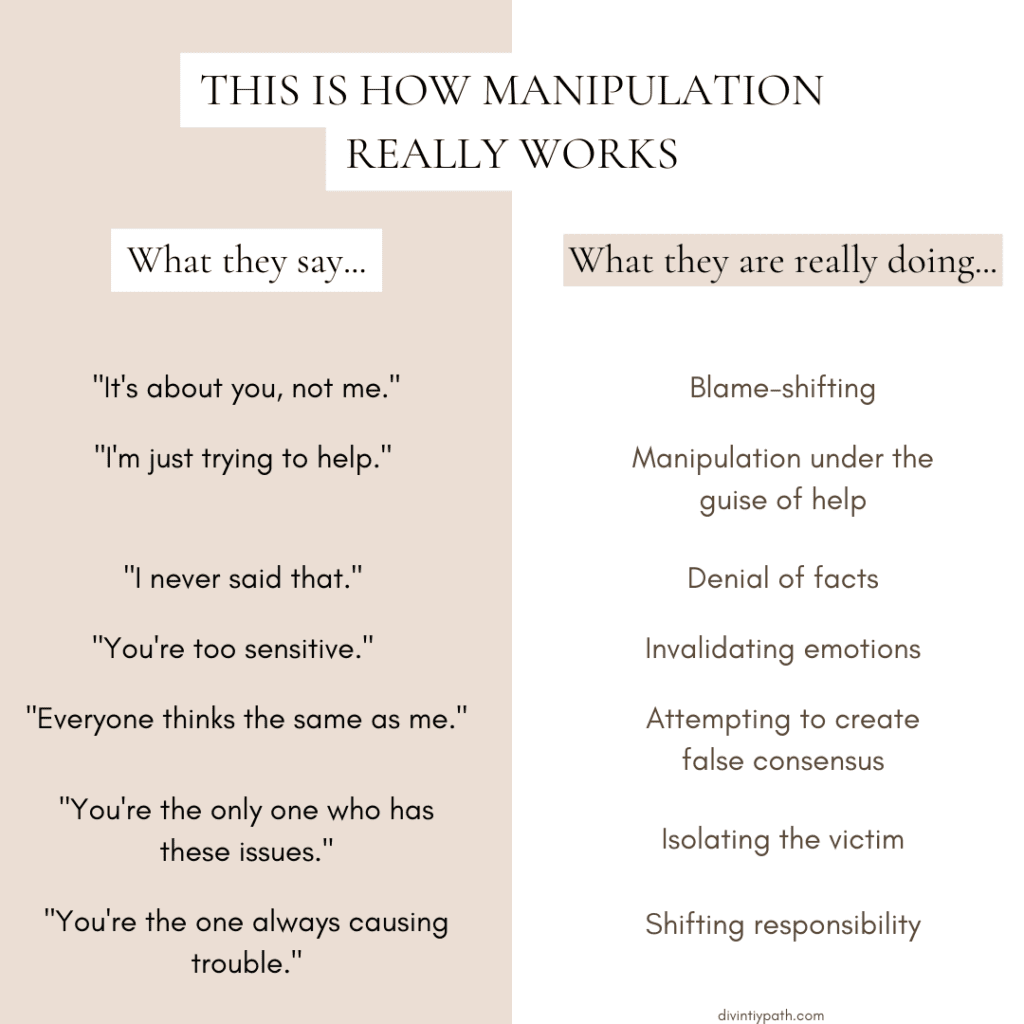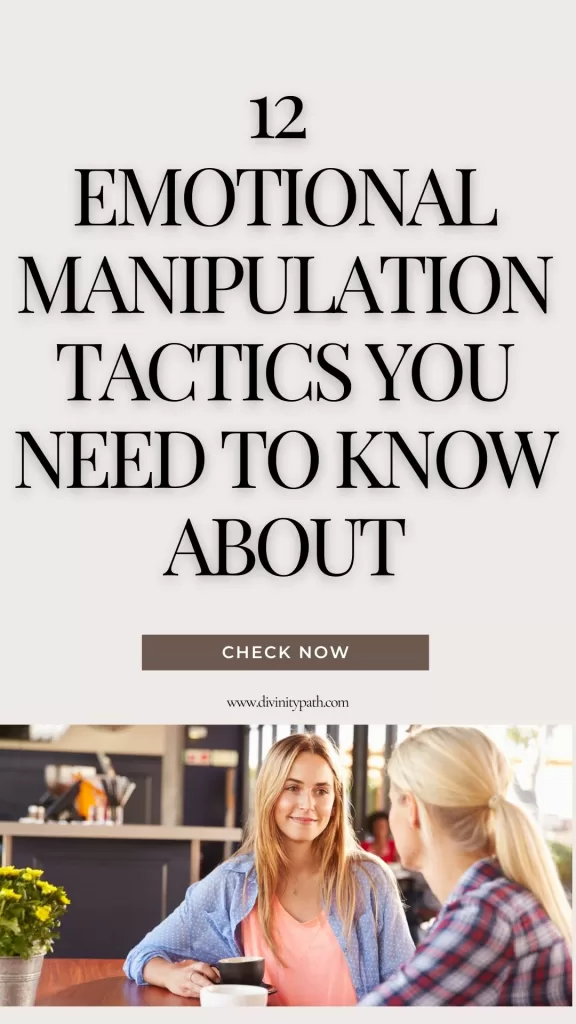12 Emotional Manipulation Tactics You Need To Know About
Has it ever happened to you that, when you’re with someone, you felt like something wasn’t quite right? As if their words and actions make you doubt yourself, even though you can’t quite explain why? It’s not a coincidence. Often, this is a form of emotional manipulation tactics, which some people use skillfully to gain power over others—in relationships, at work, or even through social media.
People who use manipulation aren’t always obvious. In fact, they’re often so convincing that we don’t even realize what’s happening. For example, one study showed how social media platforms like Facebook manipulate the content we see in order to influence our mood. A group of users was shown mostly negative posts, and as a result, they started thinking—and posting—more negatively. If an app can do that, imagine how someone who knows you well and understands your weaknesses can manipulate you.
Emotional manipulation isn’t just something that happens “out there.” It often occurs right between people who are close to us—partners, friends, even family members. Their tactics are subtle but effective, and before we know it, we can become caught in a web of self-doubt. But here’s the good news: once you understand these manipulative techniques, you can become more resilient.
In this article, I’ll share some of the most common emotional manipulation techniques, how to recognize them, and why they work. It’s possible that as you read, you might recognize situations from your own life—and that’s okay.
What is Emotional Manipulation?
Emotional manipulation is one of those things that can be hard to recognize at first glance. Manipulators often use tactics that initially seem kind and caring, but they always have a hidden agenda: to influence your emotions and decisions. It’s a subtle form of control that can deeply affect your sense of self-worth before you even realize what’s happening.
Carl Jung once said, “Until you make the unconscious conscious, it will direct your life and you will call it fate.” And that’s exactly what happens with emotional manipulation. When we fail to recognize these tactics, we can quickly become prisoners of manipulative patterns that steer our decisions and emotions.
At first glance, manipulation may seem like something positive—perhaps care, attention, or even love. But here’s the crucial question: do you feel better or worse after these “positive” actions? If, in the long run, you feel guilty, unworthy, or even powerless, it’s highly likely that you’re under the influence of emotional manipulation techniques.
Let’s say you have a friend who often says, “You know I’d do anything for you.” Sounds nice, right? But when you express a different opinion or disagree with something, this friend immediately feels offended. Instead of listening to your feelings, they start blaming you: “How can you say that? You know how much I do for our relationship.” And even though you know you haven’t done anything wrong, you start to doubt yourself.
Such emotional manipulation tactics are especially common in romantic relationships. Perhaps you’ve experienced a situation where your partner says, “I really want you to do this for me. Otherwise, I’ll be really disappointed.” And although you didn’t want to, you gave in—not because you truly wanted to please them, but because you were afraid of the guilt. Over time, these patterns lead to sacrificing your own desires and needs just to keep the peace in the relationship.
Emotional manipulation isn’t always obvious, but once you recognize these patterns, you can start standing up for yourself. The next step? Learn the signs of manipulative behavior, so we can recognize the traps before they catch us.
Emotional Manipulation Tactics You Need to Know
1. Downplaying Your Emotions
Have you ever shared that something hurt you, only to hear a response like, “You’re overreacting” or “You’re too sensitive”? This is one of the most common emotional manipulation tactics – devaluing your emotions.
By doing this, the manipulative person diminishes the importance of your feelings, making you feel insignificant or even confused. Instead of accepting your emotions as valid, they dismiss them as irrelevant. Over time, this can make you question whether your feelings are justified. You may become quieter, less confident, and often shut down conversations to avoid causing “trouble.”
Deep Questions Every Couple Needs to Explore Together
This tactic is not just unhealthy; it’s also a means of control, where the manipulator maintains power in the relationship. It’s important to recognize these signs and protect your emotions. If someone devalues your feelings, don’t hesitate to say, “My feelings matter, and I want you to respect them.” This sets clear boundaries and preserves your emotional integrity.
2. Guilt as a Tool for Control
Have you ever been made to feel guilty to get what someone else wants? For example, a colleague says, “I’ve always helped you, and now you’re leaving me hanging,” or a partner uses the line, “If you really loved me, you would do this for me.” This is one of the most common emotional manipulation tactics that exploits your emotions to achieve their goals.
Such behavior often starts innocently – they may genuinely need help or support – but once they use guilt as leverage, it becomes a tool for control. It’s designed to put you in an uncomfortable position, making it difficult to say no because you fear disappointing the other person.
Manipulators often bring up the past, mentioning everything they’ve “done for you” to tie you to a sense of obligation, even if their request is unreasonable. As therapist Saba Harouni Lurie states, this is a tactic we all use occasionally, but emotional manipulators do it intentionally and frequently.
To recognize this tactic, ask yourself: Are they asking me or pressuring me? If you feel they’re forcing you through guilt, set a boundary: “I appreciate what you’ve done for me, but that doesn’t mean I’m obligated to accept your request.” Maintaining integrity means respecting your boundaries, even if it makes someone else uncomfortable.
Is Jealousy Controlling You? Learn How to Overcome Excessive Jealousy
3. “Everyone Agrees with Me”
Have you ever heard, “Everyone says you’re exaggerating,” or “My friends agree that you’re wrong”? This tactic, one of the emotional manipulation strategies, is often used to make you feel isolated and doubt your feelings or beliefs.
The manipulator uses the supposed agreement of others to validate their own stance and weaken your confidence. For instance, if you express your needs in a relationship, your partner might say, “All my friends think your demands are unrealistic.” Instead of addressing your feelings, they reduce you to someone unsupported by others. This creates a sense of loneliness and pressure to change your viewpoint – not because it’s wrong, but because you fear having no support.
This tactic is subtle but very harmful. It operates on the principle that “most people” always know better, even though you never verify if these “people” exist or what they actually think. Often, it’s a complete fabrication designed for emotional control.
It’s important to stay firm in these situations. Trust yourself and your feelings, and ask directly: “Who exactly is saying this?” or “Do you think I should adjust my feelings because your friends think so?” Such questions often reveal the manipulative game and help you maintain confidence.
Stop Bringing Up Past Mistakes in Relationship Before It’s Too Late
4. “I Never Said That”
Has someone ever promised you something, only to later deny ever saying it? This sneaky tactic, known as gaslighting, is one of the most damaging emotional manipulation strategies. It’s intended to create doubt in your own reality, often leading to confusion, low self-esteem, and helplessness.
For example, your boss might promise you an important project that could advance your career. Weeks later, when you remind them of the promise, they say, “I never said anything like that” or “Maybe you misunderstood.” Does this sound familiar?
With this behavior, the manipulator tries to control the situation and your emotions while denying responsibility. Even if you initially stand your ground, constant opposition and denial of their actions force you to doubt yourself. Suddenly, you start questioning, “Did I really misunderstand everything?”
5. Treating You Like a Child
Have you ever felt like someone treated you as if you weren’t capable of making decisions or doing tasks on your own? This is one of the emotional manipulation tactics often used in relationships, at work, or even in friendships. The tactic of treating you like a child diminishes your confidence and control, leading to feelings of helplessness, dependency, and confusion.
Imagine you’re at work, and your boss, regardless of how well you perform your tasks, constantly micromanages and changes your decisions. Not only is this frustrating, but it starts to convince you that you’re incapable of acting independently. Over time, you begin to doubt your abilities and seek approval for every step you take.
6. Playing on Insecurity
Have you ever felt that someone knows exactly where to hit you where you’re most vulnerable? “Playing on insecurity” is one of the most common and malicious emotional manipulation tactics, where the manipulator exploits your fears, doubts, and feelings of shame to maintain control over you. It’s a tactic often used in romantic relationships, at work, or in friendships to manipulate and achieve their goals at your expense.
Take a romantic relationship example: You have a partner who knows you want to feel loved and accepted. If this person is manipulative, they’ll use your sensitivity to sow self-doubt and accuse you of being selfish or unimportant. This tactic preys on your deep insecurities and past wounds, where you may have felt neglected or unaccepted. The manipulator forces you to feel ashamed and struggle to avoid feeling “not good enough.”
7. Love Bombing
Have you ever found yourself in a situation where someone showered you with attention, gifts, and sweet words, making you feel uniquely loved and valued? At first, it may seem incredibly charming, but when it becomes overwhelming, doubt starts to creep in. Love bombing is a emotional manipulation tactic where the manipulator quickly creates a sense of intimacy and trust through intense displays of love and affection. Initially, it might feel perfect, but over time, it can begin to feel like a trap.
For example, imagine starting a new relationship where your partner inundates you with gifts, compliments, and relentless attention. At first, it seems wonderful and romantic, but gradually, it starts to feel overwhelming—everything revolves around how they’re showering you with affection, providing for you, or constantly being present. While this might make you happy initially, you may soon question: is this love genuine or just a tool to achieve hidden motives?
8. When Someone Puts Obstacles in Your Path to Success
Have you ever felt like you were on track to achieve your goals, only to encounter sudden, unforeseen hurdles that slowed you down or set you back? This isn’t always mere bad luck—it could be a emotional manipulation tactic known as progress sabotage. Manipulators often shift the goalposts to prevent their targets from succeeding, keeping them in a position of helplessness.
Imagine working hard to achieve a major career milestone—like a promotion or completing a significant project—only to have new conditions suddenly introduced that make it harder for you to succeed. This could include adding unexpected tasks not part of the original agreement or changing the rules entirely, making it nearly impossible for you to reach your goals.
9. Triangulation
Perhaps you’ve had a disagreement with someone, and suddenly, a third person steps in to take the opposing side, making you feel like you’re in the wrong. This could be triangulation—a tactic emotional manipulators frequently use to gain control over a situation.
10. Lying
Lying is one of the most basic and common tactics of emotional manipulation. A manipulator distorts the truth to achieve their goals and avoid accountability. This could range from small “white lies” to completely fabricated stories, all with the same purpose: to influence your emotions and gain control over you.
For instance, a partner might promise to do something but never follow through. When questioned, they may make excuses, lie, or even turn the situation around to their advantage. They might tell you that you’re misunderstanding things, that everything is fine, or that your expectations are unrealistic. What might initially seem like simple miscommunication can actually lead you away from the truth, leaving you feeling insecure.
The tactic of lying is particularly insidious because it erodes your trust in your own judgment. Eventually, you may start doubting yourself, wondering if you’re misinterpreting the situation, while the manipulator maintains control and avoids responsibility. Recognizing this behavior is crucial to identifying emotional manipulation and standing up for yourself.
11. Ignoring
Ignoring is one of the most common yet powerful forms of emotional manipulation. When someone deliberately ignores you, they aim to influence you by pushing you into feelings of insecurity and isolation. You might have experienced trying to reach out to someone—be it a partner, friend, or coworker—only to be met with silence. Messages go unanswered, calls are ignored, or you’re entirely excluded from conversations or decisions without any explanation.
This creates a deeply uncomfortable feeling, leading you to question what you did wrong or why someone is treating you this way. Ignoring can lead to self-doubt as you begin to wonder if you’re not important or worthy of attention. Emotional manipulators use this tactic to make you feel alone, confused, and anxious, all while maintaining control over the situation.
12. Generalizations
Generalizations often take us by surprise, trapping us in the web of emotional manipulation before we even realize it. When someone uses broad statements like “You always make the same mistake” or “You never listen to me,” it’s easy to feel caught in a cycle of guilt and helplessness.
This type of manipulation doesn’t focus on a specific action or situation but instead targets your entire personality, leaving you feeling confused and hurt.
Think about times when someone in a conversation frequently says things like, “You always” or “You never,” even though you’ve tried to improve the situation or change your behavior. This makes you feel irredeemable, distorting your view of the real issue and leading to a sense of worthlessness. Instead of addressing a specific action or problem, this manipulation creates the illusion that all your mistakes are inherent to your nature—which is far from true.











